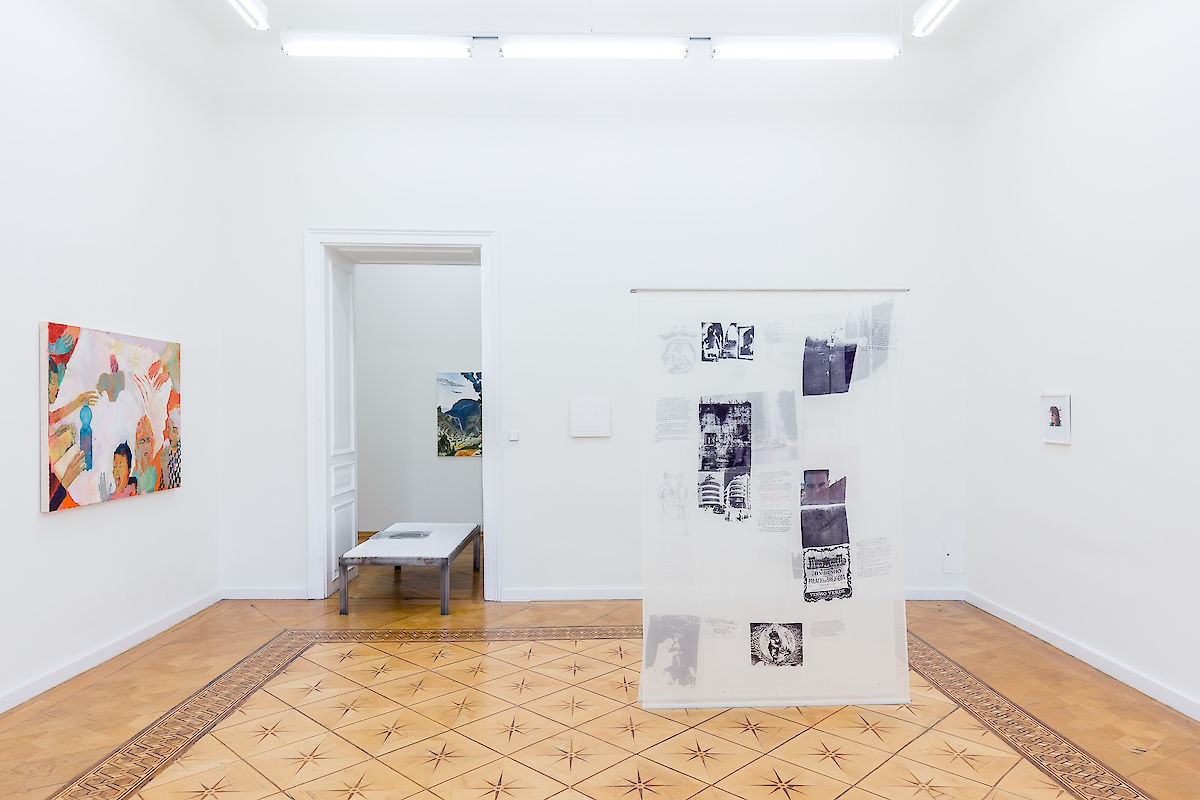All’estero & Dr. K.’s Badereise nach Riva: Version B
13 Sep - 27 Oct 2018
ALL’ESTERO & DR. K.’S BADEREISE NACH RIVA: VERSION B
13 September – 27 October 2018
curated by_Saim Demircan
Marc Camille Chaimowicz, Whitney Claflin, Oliver Croy and Oliver Elser, Stephan Dillemuth, Georgia Gardner Gray, Rochelle Goldberg, Philipp Gufler, Ernst Herbeck, Tess Jaray, Martin Kippenberger, Nick Mauss, Marina Sula, Mark Van Yetter, Dario Wokurka, Miriam Yammad
In the second and third chapters of Schwindel. Gefühle, writer W.G. Sebald makes repeated trips from Vienna to Venice, firstly as himself, or rather, a version of himself in 1980 and 1987; and then again following a certain Dr K. in 1913, who travels on to a sanatorium in Riva at Lake Garda.
As well as dizziness, on its own the German Schwindel also means swindle, deception and legerdemain. Similarly, the text is a confidence trick. In the chapter ‘Dr K. Takes the Waters at Riva’, Dr K. is Franz Kafka, and the passage between Austria and Italy is based on a documented business trip made by the Czech writer when he worked at Prague Worker’s Insurance Company.
Duplicitous mirroring of literary figures and historiography through mental projection and travel is an inherent characteristic of Sebald’s writing. Authors, playwrights and poets cameo throughout these chapters, either directly or obliquely. In Vienna, he thinks he sees Dante on Gonzagagasse and meets Ernst Herbeck. Dr K. dines with Grillparzer at Hotel Matschakerhof and visits the Prater with Otto Pick and Albert Ehrenstein, whose similitude can be seen in a photograph of them ‘taken as if passengers on an aeroplane, which appears to be flying above the big Ferris wheel and the spires of the Votivkirche’.
Elsewhere, in Venice, Sebald meets Salvatore Altamura, [GJ2] who shares the first[GJ3] name of the burgomaster in Kafka’s short story The Hunter Gracchus, and is reimagined by the writer as ‘Salvatore, the podestà in Riva’. He also speculates on whether Dr K. saw the 1913 German Expressionist film Der Student von Prag at the cinema Pathé di San Sebastiano and ‘recognized a kind of doppelgänger’ in the scene where the reflection of the eponymous hero walks out of a mirror.
Recurring symbolism, paranoiac doubling, and in-between states such as hypnagogic hallucination distort the text with signs and both chapters are rich with premonition. As such, ‘All’estero & Dr K. Takes the Waters at Riva: Version B’ creates another layer of duplication through exhibition-making, using narrative devices that connect these two chapters to illustrate the writer’s complex fictionalization of his own life. Intertextuality, resemblance, and the mnemonic in relation to place feature prominently in artworks, ephemera and literature that take inspiration from Sebald’s writing. With an accent on the city as the origin of this journey, the show charts an ambulatory route connecting events, characters and affect.
Text by Saim Demircan
13 September – 27 October 2018
curated by_Saim Demircan
Marc Camille Chaimowicz, Whitney Claflin, Oliver Croy and Oliver Elser, Stephan Dillemuth, Georgia Gardner Gray, Rochelle Goldberg, Philipp Gufler, Ernst Herbeck, Tess Jaray, Martin Kippenberger, Nick Mauss, Marina Sula, Mark Van Yetter, Dario Wokurka, Miriam Yammad
In the second and third chapters of Schwindel. Gefühle, writer W.G. Sebald makes repeated trips from Vienna to Venice, firstly as himself, or rather, a version of himself in 1980 and 1987; and then again following a certain Dr K. in 1913, who travels on to a sanatorium in Riva at Lake Garda.
As well as dizziness, on its own the German Schwindel also means swindle, deception and legerdemain. Similarly, the text is a confidence trick. In the chapter ‘Dr K. Takes the Waters at Riva’, Dr K. is Franz Kafka, and the passage between Austria and Italy is based on a documented business trip made by the Czech writer when he worked at Prague Worker’s Insurance Company.
Duplicitous mirroring of literary figures and historiography through mental projection and travel is an inherent characteristic of Sebald’s writing. Authors, playwrights and poets cameo throughout these chapters, either directly or obliquely. In Vienna, he thinks he sees Dante on Gonzagagasse and meets Ernst Herbeck. Dr K. dines with Grillparzer at Hotel Matschakerhof and visits the Prater with Otto Pick and Albert Ehrenstein, whose similitude can be seen in a photograph of them ‘taken as if passengers on an aeroplane, which appears to be flying above the big Ferris wheel and the spires of the Votivkirche’.
Elsewhere, in Venice, Sebald meets Salvatore Altamura, [GJ2] who shares the first[GJ3] name of the burgomaster in Kafka’s short story The Hunter Gracchus, and is reimagined by the writer as ‘Salvatore, the podestà in Riva’. He also speculates on whether Dr K. saw the 1913 German Expressionist film Der Student von Prag at the cinema Pathé di San Sebastiano and ‘recognized a kind of doppelgänger’ in the scene where the reflection of the eponymous hero walks out of a mirror.
Recurring symbolism, paranoiac doubling, and in-between states such as hypnagogic hallucination distort the text with signs and both chapters are rich with premonition. As such, ‘All’estero & Dr K. Takes the Waters at Riva: Version B’ creates another layer of duplication through exhibition-making, using narrative devices that connect these two chapters to illustrate the writer’s complex fictionalization of his own life. Intertextuality, resemblance, and the mnemonic in relation to place feature prominently in artworks, ephemera and literature that take inspiration from Sebald’s writing. With an accent on the city as the origin of this journey, the show charts an ambulatory route connecting events, characters and affect.
Text by Saim Demircan

